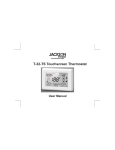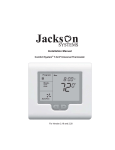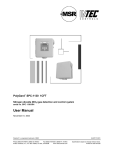Download T-32-TS Installation Manual.cdr
Transcript
COMF RT SYSTEM™ T-32-TS Touchscreen Thermostat Installation Manual TABLE OF CONTENTS Introduction Getting Started Installing The Thermostat Disassembly Thermostat Location Mounting The Subbase Terminal Designations Setting The System Switches System Switch Functions Installing The Batteries Typical System Wiring Diagrams Heat Only (Gas) Heat Only (Electric) Cool Only 1 Heat / 1 Cool (Gas) 2 Heat / 2 Cool (Gas) 2 Heat / 1 Cool Heat Pump 3 Heat / 2 Cool Heat Pump 2 Heat / 1 Cool Fossil Fuel 3 Heat / 2 Cool Fossil Fuel 4 5 6 6 6 6, 7 8 9 10 11 12 12 13 14 15 16 17 18 19 20 1 TABLE OF CONTENTS Installer Setup Menu Entering The Setup Menu Selecting The Program Selecting Program Days Selecting Temporary Program Override Selecting Programmable Fan Mode Selecting Mode Selecting Touchscreen Lock Options Selecting The Cooling Setpoint Limit Selecting The Heating Setpoint Limit Selecting The Temperature Display Selecting The Time Format Selecting The Setpoint Display Option Selecting Back Light Option Selecting Adaptive Recovery Option Selecting Filter Reminder Selecting First Stage Heating And Cooling Differential Option Selecting Second Stage Heating And Cooling Differential Option Selecting Third Stage Heating Differential Option Selecting Internal Or Indoor Remote Sensor Calibration Option Selecting Remote Sensor Option Selecting Equipment Configuration 2 21 21 22 23 24 25 26 27 28 29 30 31 32 33 34 35 36 37 38 39 40 41 TABLE OF CONTENTS Selecting Low Balance Point Option Selecting High Balance Point Option Selecting Audible Beep Option Selecting The Factory Default Option Selecting Daylight Savings Time Option Remote Sensor Installation Remote Sensors Indoor Sensor Wiring Using Multiple Sensors For Temperature Averaging Outdoor Sensor Wiring Temperature Calibration Chart Testing Testing Fan Operation Testing Conventional Heating And Cooling Operation Testing Conventional Heat Pump Operation Testing Fossil Fuel Operation Testing Low Balance Point (Heat Pump or Fossil Fuel) Testing High Balance Point (Heat Pump or Fossil Fuel) Adaptive Recovery Basic Trouble Shooting T-32-TS Specifications 3 42 43 44 45 46 47 47 47, 48 49 50 51 52 52 52, 53 53 53, 54 54 54, 55 55 56, 58 59 INTRODUCTION The Comfort System™ T-32-TS is a feature-rich touchscreen thermostat that can be battery powered or hardwired to the HVAC equipment. Using a common sense approach to the installation will ensure this product is installed properly and to the customer’s satisfaction. Please take time to read and understand this manual so that installation and testing is performed in an efficient manner. This manual is to be used in conjunction with the supplied User Manual. Although great care has been taken in the preparation of this manual, Jackson Systems takes no responsibility for errors or omissions contained herein. It is the responsibility of the installer to ensure that this thermostat and the equipment connected to it operate in a safe and efficient manner. Due to ongoing product improvements, Jackson Systems reserves the right to change the specifications of the T-32-TS thermostat or its components without notice. All rights reserved. ©Jackson Systems, LLC 2012. Intellectual rights apply. 4 GETTING STARTED As with any HVAC project, careful installation is the key to a successful outcome. Tim taken during the installation process will be rewarded with fewer call-backs. The steps required to install the T-32-TS thermostat are as follows. 1. Read and understand this Installation Manual and User Manual 2. Mount and wire the subbase. 3. Install the batteries. 4. Set the 4 system switches to match the equipment application. Heat / Cool Heat Pump Fossil Fuel 5. Wire optional remote temperature sensor(s). 6. Power the thermostat 7. Set the Advanced Installer settings. 8. Test the thermostat. 5 INSTALLING THE THERMOSTAT DISASSEMBLY There are two release slots located on the bottom of the thermostat. Gently push the flat blade of a small screwdriver into one slot at a time and pry upward until the catch disengages. Carefully swing the thermostat upward and away from the subbase. THERMOSTAT LOCATION The T-32-TS should be installed in a location that represents the ambient space temperature. Do not install the thermostat in an area where drafts are present, near the floor, behind doors or on an external wall. Avoid placing the thermostat in areas where the air movement is limited, affected by direct sunlight or other areas not typical of the temperature in the space. MOUNTING THE SUBBASE When mounting the T-32-TS subbase, be aware that drafts may travel down wall cavities and enter the back of the thermostat through the control wire hole in the wall. It is important to seal the 6 FIGURE 1 INSTALLING THE THERMOSTAT hole to prevent any drafts that might affect the internal temperature sensor. Pull the control wires through the large opening in the thermostat subbase. Next, level and mount the subbase on the wall using the supplied anchors and screws. (Figure 2) Do not over tighten the mounting screws as the subbase may warp causing the improper seating of the thermostat connecting pins to the terminal blocks. Use a properly sized screwdriver and back each screw terminal out (counter clockwise) before landing each wire to its dedicated terminal. Do not over tighten the terminal screws. Check to ensure that all wires are landed correctly and dressed properly to prevent any shorts. Refer to Typical System Wiring Diagrams in this manual for proper wiring. Jackson Systems, LLC BATTERY COMPARTMENT www.jacksonsystems.com MOUNTING HOLES W2 S2 SC S1 O/B W1 WIRE ACCESS HOLE MOUNTING HOLE FIGURE 2 7 MOUNTING HOLES Y1 Y2 G R C INSTALLING THE THERMOSTAT TERMINAL DESIGNATIONS TERMINAL S2 SC S1 W2/OB W1 Y1 Y2 G R C DESIGNATION Outdoor Sensor Sensor Common Indoor Sensor Second Stage Heat or Reversing Valve First Stage Heat / Auxiliary / Emergency Heat First Stage Cool or First Stage Compressor Second Stage Cool or Second Stage Compressor Fan 24 VAC Hot 24 VAC Common 8 SETTING THE SYSTEM SWITCHES The T-32-TS contains a set of four system switches located on the thermostat printed circuit board. (Figure 3) The switches are used to match the thermostat operation and relay outputs with the HVAC system requirements. Refer to the system switch functions on the next page to properly configure the thermostat. ..... FIGURE 3 9 1234 ..... ON SYSTEM SWITCHES SYSTEM SWITCH FUNCTIONS Switch 1 - Equipment Type Switch 1 sets the equipment type. For conventional heat / cool equipment, set the switch to the OFF position (factory default). For heat pump equipment set the switch to the ON position. Switch 2 - Fan or Reversing Valve When Switch 1 is OFF For Gas heat, set the switch to the OFF position (factory default). For electric heat, set the switch to the ON position. When Switch 1 is ON For ‘O’ reversing valve, set the switch to the OFF position (factory default). For ‘B’ reversing valve, set the switch to the ON position. Switch 3 - Short Cycle Timer For 4 minute short cycle protection, set switch to the OFF position (factory default). To disable short cycle protection, set switch to the ON position. Switch 4 - Fossil Fuel Mode For conventional heat pump equipment, leave switch in the OFF position (factory default). For fossil fuel equipment, set switch to the ON position. 10 INSTALLING THE BATTERIES The T-32-TS comes with two AAA batteries. Even if the thermostat is hardwired, battery backup is recommended to maintain the real-time clock in the event of a power failure. All other memory is non-voilatile in the event of battery or primary power loss. Press in on the battery access compartment and slide the drawer out. Install the two AAA batteries matching the + and - orientation. Push the battery compartment in until it clicks shut. When the batteries are properly installed, the touchscreen display will light up. (Figure 4) + FIGURE 4 11 TYPICAL SYSTEM WIRING DIAGRAMS HEAT ONLY (GAS) OPTIONAL REMOTE SENSOR TERMINALS S2 SC S1 W2 O/B W1 Y1 Y2 G R C THERMOSTAT EQUIPMENT OUTDOOR SENSOR INDOOR SENSOR HEAT 1 RELAY Switch Settings Switch 1 = OFF Switch 2 = OFF Switch 3 = OFF Switch 4 = OFF FAN 1 RELAY 24 V Heat / Cool Equipment controls fan on call for heat Short Cycle Protection (No affect on setup) Leave OFF 12 LINE TYPICAL SYSTEM WIRING DIAGRAMS HEAT ONLY (Electric) OPTIONAL REMOTE SENSOR TERMINALS S2 SC S1 W2 O/B W1 Y1 Y2 G R C THERMOSTAT EQUIPMENT OUTDOOR SENSOR INDOOR SENSOR HEAT 1 RELAY Switch Settings Switch 1 = OFF Switch 2 = ON Switch 3 = OFF Switch 4 = OFF FAN 1 RELAY 24 V Heat / Cool Thermostat controls fan on call for heat Short Cycle Protection (No affect on setup) Leave OFF 13 LINE TYPICAL SYSTEM WIRING DIAGRAMS COOL ONLY OPTIONAL REMOTE SENSOR TERMINALS S2 SC S1 W2 O/B W1 Y1 Y2 G R C THERMOSTAT EQUIPMENT OUTDOOR SENSOR INDOOR SENSOR COOL 1 RELAY Switch Settings Switch 1 = OFF Switch 2 = OFF Switch 3 = OFF Switch 4 = OFF FAN 1 RELAY 24 V Heat / Cool Fan energized on call for cooling Short Cycle Protection (Recommended) Leave OFF 14 LINE TYPICAL SYSTEM WIRING DIAGRAMS 1 HEAT / 1 COOL (GAS) OPTIONAL REMOTE SENSOR TERMINALS S2 SC S1 W2 O/B W1 Y1 Y2 G R C THERMOSTAT EQUIPMENT OUTDOOR SENSOR INDOOR SENSOR HEAT 1 RELAY Switch Settings Switch 1 = OFF Switch 2 = OFF Switch 3 = OFF Switch 4 = OFF COOL 1 RELAY FAN 1 RELAY 24 V Heat / Cool Fan energized on call for cooling Short Cycle Protection (Recommended) Leave OFF 15 LINE TYPICAL SYSTEM WIRING DIAGRAMS 2 HEAT / 2 COOL (GAS) OPTIONAL REMOTE SENSOR TERMINALS S2 SC S1 W2 O/B W1 Y1 Y2 G R C THERMOSTAT OUTDOOR SENSOR HEAT 1 RELAY INDOOR SENSOR HEAT 2 RELAY Switch Settings Switch 1 = OFF Switch 2 = OFF Switch 3 = OFF Switch 4 = OFF COOL 2 RELAY COOL 1 RELAY FAN 1 RELAY EQUIPMENT 24 V Heat / Cool Fan energized on call for cooling Short Cycle Protection (Recommended) Leave OFF 16 LINE TYPICAL SYSTEM WIRING DIAGRAMS 2 HEAT / 1 COOL (HEAT PUMP) OPTIONAL REMOTE SENSOR TERMINALS S2 SC S1 W2 O/B W1 Y1 Y2 G R C THERMOSTAT OUTDOOR SENSOR EQUIPMENT AUX RELAY INDOOR SENSOR REV VALVE Switch Settings Switch 1 = ON Switch 2 = OFF/ON Switch 3 = OFF Switch 4 = OFF COMP COOL 1 RELAY FAN 1 RELAY 24 V Heat Pump OFF = ‘O’ ON = ‘B’ Short Cycle Protection (Recommended) Leave OFF 17 LINE TYPICAL SYSTEM WIRING DIAGRAMS 3 HEAT / 2 COOL (HEAT PUMP) OPTIONAL REMOTE SENSOR TERMINALS S2 SC S1 W2 O/B W1 Y1 Y2 G R C THERMOSTAT OUTDOOR SENSOR AUX RELAY INDOOR SENSOR REV VALVE Switch Settings Switch 1 = ON Switch 2 = OFF/ON Switch 3 = OFF Switch 4 = OFF COMP 2 RELAY COMP COOL 1 RELAY FAN 1 RELAY EQUIPMENT 24 V Heat Pump OFF = ‘O’ ON = ‘B’ Short Cycle Protection (Recommended) Leave OFF 18 LINE TYPICAL SYSTEM WIRING DIAGRAMS 2 HEAT / 1 COOL (FOSSIL FUEL) OPTIONAL REMOTE SENSOR TERMINALS S2 SC S1 W2 O/B W1 Y1 Y2 G R C THERMOSTAT OUTDOOR SENSOR EQUIPMENT AUX RELAY INDOOR SENSOR REV VALVE Switch Settings Switch 1 = ON Switch 2 = OFF/ON Switch 3 = OFF Switch 4 = ON COMP COOL 1 RELAY FAN 1 RELAY 24 V LINE Heat Pump OFF = ‘O’ ON = ‘B’ Reversing Valve Short Cycle Protection (Recommended) Locks out heat pump when furnace is energized 19 TYPICAL SYSTEM WIRING DIAGRAMS 3 HEAT / 2 COOL (FOSSIL FUEL) OPTIONAL REMOTE SENSOR TERMINALS S2 SC S1 W2 O/B W1 Y1 Y2 G R C THERMOSTAT OUTDOOR SENSOR AUX RELAY INDOOR SENSOR REV VALVE Switch Settings Switch 1 = ON Switch 2 = OFF/ON Switch 3 = OFF Switch 4 = ON COMP 2 RELAY COMP COOL 1 RELAY FAN 1 RELAY EQUIPMENT 24 V LINE Heat Pump OFF = ‘O’ ON = ‘B’ Reversing Valve Short Cycle Protection (Recommended) Locks out heat pump when furnace is energized 20 INSTALLER SETUP MENU ENTERING THE SETUP MENU Touch and hold both the Clock and Mode section for 5 seconds to enter the Installer Menu. E AM DST E 01/01/2012 • • • To advance through the menu, touch the Mode section. To backup in the menu, touch the Fan section. To exit the menu at any time and save changes, touch and hold the Mode section until the display shows normal operation. 21 INSTALLER SETUP MENU Back Program Morning Day Evening Night E SELECTING THE PROGRAM The first menu 1:PR selects programmable or non-programmable operation. Press the UP or DOWN arrows to change the selection. The factory default is 4 (4 schedules per day). Next 0 = Manual Mode (non-programmable) 2 = 2 Schedules Per Day (Day / Night) 4 = 4 Schedules Per Day (Morning / Day / Evening / Night 22 INSTALLER SETUP MENU E SELECTING PROGRAM DAYS If menu 1:PR is set to 2 or 4, 2:PD is used to select 5+2 programming or 7 day programming. Touch the UP or DOWN arrows to change the selection. The factory default is 7. Back Next 51 = 5+1+1 (Same schedule Mon-Fri and separate schedules for Sat and Sun) 52 = 5 + 2 (Same schedule Mon-Fri and Sat-Sun) 7 = 7 (7 individual day programming) 23 INSTALLER SETUP MENU Back E SELECTING TEMPORARY PROGRAM OVERRIDE Menu 3:TH provides temporary program override. When OFF, (factory default) a change in setpoint will remain until the next scheduled event or a fixed override can be set from 1-12 hours. Use the UP or DOWN arrows to select override time. Program Next OFF = Provides override to next scheduled event 1-12 = Override to selected time (1 - 12 hours in 1 hour increments) 24 INSTALLER SETUP MENU Back E SELECTING PROGRAMMABLE FAN MODE Menu 4:PF is the Programmable Fan option which allows selecting continuous or auto fan operation for each program event. The factory default is OFF. Use the UP or DOWN arrows to select Programmable Fan. Program Next ON = Programmable Fan OFF = No Programmable Fan Refer to the User Manual for selecting continuous or auto fan for each scheduled event when the Programmable Fan option is ON. 25 INSTALLER SETUP MENU E SELECTING MODE Menu 5:FN selects the mode of operation. The factory default is A for auto changeover. Touch the UP or DOWN arrows to change the selection. Next Back AUTO - = Manual Changeover A = Auto Changeover (Heat / Cool / Auto / Off H = Heat / Off C = Cool / Off Ao = Auto / Off Note: In Manual Changeover configuration the heating and cooling setpoint can be the same. 26 INSTALLER SETUP MENU E SELECTING TOUCHSCREEN LOCK OPTIONS Menu 6:LC allows you to prevent changes to all or part of the touchscreen functions. The factory default is OFF. Touch the UP or DOWN arrows to change the selection. Next Back OFF 1 2 3 4 5 = All functions unlocked = Program locked = Mode locked = Fan locked = UP / DOWN arrows locked = Clock locked 6 7 8 9 27 = Fan / Mode locked = Fan / Program / Mode locked = Fan / Program / Mode / Clock locked = All functions locked INSTALLER SETUP MENU Set E SELECTING THE COOLING SETPOINT LIMIT Menu 7:CL selects the minimum cooling setpoint. The factory default is 50. Touch the UP or DOWN arrows to adjust the limit from 43° - 122°F. Next Back 28 INSTALLER SETUP MENU Heat Set E SELECTING THE HEATING SETPOINT LIMIT Menu 8:HL selects the maximum heating setpoint limit. The factory default is 90. Touch the UP or DOWN arrows to adjust the limit from 41° - 120°F. Next Back 29 INSTALLER SETUP MENU E SELECTING THE TEMPERATURE DISPLAY Menu 9:TD selects the temperature to be displayed in Fahrenheit or Celsius. The factory default is F (Fahrenheit). Touch the UP or DOWN arrows to change the display setting. Next Back F = Fahrenheit C = Celsius 30 INSTALLER SETUP MENU E SELECTING THE TIME FORMAT Menu 10:CL selects the time format which can be 12 hour or 24 hour. The factory deault is 12 (12 hour). Touch the UP or DOWN arrows to change the format. Next Back 12 = 12 Hour 24 = 24 Hour (Military Time) 31 INSTALLER SETUP MENU Set E SELECTING THE SETPOINT DISPLAY OPTION Menu 11:ST allows the option of continuously displaying the setpoint temperture with the space temperature or only the sepoint temperature. The factory default is ON (Setpoint Displayed). Touch the UP or DOWN arrows to change the display option. Next Back ON = Setpoint displayed OFF = No sepoint displayed 32 INSTALLER SETUP MENU E SELECTING BACK LIGHT OPTION Menu 12:BL allows you to select the back light option. The factory default is ON. Touch the UP or DOWN arrows to change the display option. Next Back ON = Back Light on for 10 seconds when screen is touched OFF = No Back Light ALL = Back Light on high for 10 seconds when screen is touched and then low continuously. (Thermostat must be hardwired to 24VAC for this option) 33 INSTALLER SETUP MENU E SELECTING ADAPTIVE RECOVERY OPTION Menu 13:RC allows you to select the Adaptive Recovery option when the thermostat is configured as programmable. Adaptive Recovery compares the space temperature deviation from setpoint and rate of recovery history to bring the equipment on and reach the setpont at the scheduled start time. The factory default is OFF. Touch the UP or DOWN arrows to select this option. Next Back OFF = No Adaptive Recovery ON = Adaptive Recovery On (For programmable mode only) 34 INSTALLER SETUP MENU E SELECTING FILTER REMINDER Menu 14:FT allows you to select a time when the thermostat will display FLT as a reminder that the HVAC system filter(s) should be replaced. The factory default is OFF. Touch the UP or DOWN arrows to set the filter reminder time. Next Back OFF = No filter reminder 010 = 100 Hours 100 = 1000 Hours (Up to 9,000 hours in 100 hour steps) To reset the Filter Reminder, touch and hold Mode and Fan. 35 INSTALLER SETUP MENU E SELECTING FIRST STAGE HEATING AND COOLING DIFFERENTIAL OPTION Menu 15:S1 is used to adjust the heating and cooling differential. The factory default is 2 ( 2°F). This represents the temperature above the cooling setpoint or below the heating setpoint when the equipment is energized. Touch the UP or DOWN arrows to change the differential. Next Back 1 = 1°F Differential 2 = 2°F Differential 3 = 3°F Differential 36 INSTALLER SETUP MENU E SELECTING SECOND STAGE HEATING AND COOLING DIFFERENTIAL OPTION Menu 16:S2 is used to adjust the second stage heating and cooling differential. The factory default is 2 ( 2°F). This represents the temperature above the first stage cooling differential or below the first stage heating differential when second stage is energized. There is a 3 minute time delay before second stage is energized. Touch the UP or DOWN arrows to change the differential. Next Back Adjustable from 1 - 10°F in 1° increments 37 INSTALLER SETUP MENU E SELECTING THIRD STAGE HEATING DIFFERENTIAL OPTION Menu 17:S3 is used to adjust the third stage heating differential. The factory default is 2 ( 2°F). This represents the temperature below the second stage heating differential when third stage heat is energized. There is a 3 minute time delay before third stage heat is energized. Touch the UP or DOWN arrows to change the differential. Next Back Adjustable from 1 - 10°F in 1° increments 38 INSTALLER SETUP MENU E SELECTING INTERNAL OR INDOOR REMOTE SENSOR CALIBRATION OPTION Menu 18:CA is used to re-calibrate the thermostat internal sensor when 19:TT = OFF, or a single remote indoor sensor when 19:TT = RS . Touch the UP or DOWN arrows to adjust the calibration. The factory default is 0. Next Back Adjustable from -9° to +9°F in 1° increments 39 INSTALLER SETUP MENU E SELECTING REMOTE SENSOR OPTION Menu 19:TT allows you to select indoor remote sensor only or remote sensor with internal sensor for temperature averaging. The factory default is OFF. Touch the UP or DOWN arrows to select the desired remote sensor option. Next Back OFF = Internal sensor only RS = Indoor remote sensor only AU = Internal sensor with indoor remote sensor 40 INSTALLER SETUP MENU E SELECTING EQUIPMENT CONFIGURATION Menu 20:R4 is used to select the specific equipment configuration. The factory default is 1S for Heat / Cool and H2 for heat pump and fossil fuel. Touch the UP or DOWN arrows to select the proper equipment configuration. Next Back HEAT / COOL HEAT PUMP FOSSIL FUEL 1S = Single Stage 2S = Multi-stage OFF = 1 Heat / 1 Cool H2 = 2 Heat / 1 Cool H3 = 3 Heat / 2 Cool H2 = 2 Heat / 1 Cool H3 = 3 Heat / 2 Cool 41 INSTALLER SETUP MENU E SELECTING LOW BALANCE POINT OPTION Menu 21:LB allows you to select a low balance point setting when the thermostat is configured for Heat Pump or Fossil Fuel. When the outdoor temperature falls below the balance point setting, the compressor is locked out and only auxiliary electric heat or fossil fuel furnace is used for heating. The factory default is OFF. Touch the UP or DOWN arrows to select an low balance point setting. Next Back Adjustable from OFF, 1° to 77°F Remote outdoor sensor must be used 42 INSTALLER SETUP MENU E SELECTING HIGH BALANCE POINT OPTION Menu 22:HB allows you to select a high balance point setting when the thermostat is configured for Heat Pump or Fossil Fuel. When the outdoor temperature rises above the balance point setting, the auxiliary electric heat or fossil fuel furnace is locked out and only the heat pump is used for heating. The factory default is OFF. Touch the UP or DOWN arrows to select an low balance point setting. Next Back Adjustable from OFF, 32° to 122°F Remote outdoor sensor must be used 43 INSTALLER SETUP MENU E SELECTING AUDIBLE BEEP OPTION Menu 23:BP allows you to turn the audible beep on or off. The factory default is ON. Touch the UP or DOWN arrows to change the setting. Next Back ON = Audible beep when screen is touched OFF = No audible beep 44 INSTALLER SETUP MENU E SELECTING THE FACTORY DEFAULT OPTION Menu 24:RS can be used to reset the thermostat to the original factory defaults. The factory default is OFF. To reset the thermostat, touch the UP or DOWN arrows and set to ON. Next Back OFF = Factory default disabled ON = Factory default enabled 45 INSTALLER SETUP MENU E SELECTING DAYLIGHT SAVINGS TIME OPTION Menu 25:DS is used to enable Daylight Savings Time for the real-time clock. The factory default setting is ON. To disable this option, use the UP or DOWN arrows and set to OFF. Next Back ON = Daylight Saving Time OFF = Daylight Saving Time disabled Refer to User Manual to set Daylight Saving Time Calender 46 REMOTE SENSOR INSTALLATION REMOTE SENSORS There are two types of remote sensors. The T-32-S1 is a single sensor that can be used indoors or outdoors. The T-32-S2 contains two sensors. A combination of both sensors can be used for indoor temperature averaging with or without the onboard sensor. Use separate 18-2 shielded cable when wiring sensors to prevent interference. INDOOR SENSOR WIRING When the T-32-S1 is used as an indoor sensor, the T-32-TS can be configured to allow only the remote sensor to control the temperature or a combination of remote and onboard sensors can be used for temperature averaging. Refer to 18:TT in the installer setup menu to select the proper remote sensor option. The indoor sensor wires to terminals S1 and SC. S2 SC S1 FIGURE 5 T-32-S1 SENSOR 47 REMOTE SENSOR INSTALLATION Locate the sensor in the same manner as the thermostat. Mount the sensor 18” away from any outside wall. Do not install the sensor behind doors, in corners or other dead air spaces. Keep the sensor away from direct air flow, supply registers or near sources of heat such as lamps and appliances. The maximum wire length from the sensor to the thermostat is 300 feet. Use a separate 18-2 shielded cable for sensor wiring. Prior to wiring the sensor to the thermostat, use an ohm-meter or multi-meter to measure the resistance of the sensor. Measure at the end of the wires that will connect to the thermostat. Confirm the resistance value (within 5%) to the temperature where the sensor is mounted. Use a quality digital electronic thermometer to read the temperature at the sensor. Remove the sensor cover and place the thermometer probe next to the sensor element to verify an accurate reading. Disconnect power to the thermostat when wiring the sensor, strip only as much insulation off of the wires as necessary to provide a good contact with the terminals. The sensor is not polarity specific so either sensor lead may be connected to the SC or S1 terminals on the thermostat. 48 REMOTE SENSOR INSTALLATION USING MULTIPLE SENSORS FOR TEMPERATURE AVERAGING Multiple indoor remote sensors can be wired in series/parallel for temperature averaging. The total value of the sensors must equal 10KΩ @ 77° F. The onboard sensor is not part of the equation even if it is configured as part of the averaging circuit. However, when the onboard sensor is used with remote sensors, it represents 50% of the averaging value. Figure 6 illustrates two T-32-S2 sensors used for averaging. S2 SC S1 FIGURE 6 T-21-S2 SENSOR 49 T-21-S2 SENSOR REMOTE SENSOR INSTALLATION OUTDOOR SENSOR WIRING When the T-32-S1 is used as an outdoor sensor, the T-32-TS thermostat will display the outside air temperature as well as control high and low balance points for heat pump and fossil fuel systems. Refer to 18:TT in the installer setup menu to select the proper sensor option. The outdoor sensor wires to the SC and S2 terminals on the thermostat. Figure 7 illustrates both an indoor and outdoor sensor configuration. Mount the sensor on a vertical exterior surface below an overhang. Choose a location protected from direct sunlight and exposure to excessive moisture. Follow the same wiring procedures as installing an indoor sensor. OUTDOOR SENSOR S2 SC S1 T-32-S1 SENSOR FIGURE 7 INDOOR SENSOR T-32-S1 SENSOR 50 TEMPERATURE CALIBRATION CHART Temperature (°F) Resistance (KΩ) Temperature ( F) Resistance (KΩ) 30 34.6 70 11.9 40 26.1 80 9.4 50 19.9 90 7.4 60 15.3 100 5.9 NTC type 2 sensor - 10KΩ @ 77° F 51 TESTING The T-32-TS incorporates a short-cycle timer which can be disabled during testing by setting slide switch 3 to the ON position. Once testing is completed, the time should be enabled by setting the switch to OFF. TESTING FAN OPERATION Touch MODE until the word OFF is displayed. Touch FAN until the words Always On appear. After a brief moment, the internal fan relay ‘G’ will energize and the system fan should operate. Touch FAN again until the word Automatic appears. After a brief moment, the internal fan relay will de-energize and the system fan will shut off. TESTING CONVENTIONAL HEATING AND COOLING OPERATION Touch MODE until the word Heat appears. Touch the UP arrow and raise the setpoint above the space temperature and the first stage differential. After a brief moment, the internal heating relay ‘W1’ will energize and the heating system should operate. The word Heat will flash continuously. If the thermostat has been configured for two stage heating, raise the setpoint above the second stage differential and the second stage heating relay ‘W2’ will energize. The word Heat will flash twice, pause and repeat the sequence to indicate second stage has been energized. 52 TESTING Touch MODE until the word Cool appears. Touch the DOWN arrow and lower the setpoint below the space temperature and the first stage cooling differential. After a brief moment, the internal heating relay ‘Y1’ will energize and the cooling system should operate. The word Cool will flash continuously. If the thermostat has been configured for two stage cooling, lower the setpoint below the second stage differential and the second stage cooling relay ‘Y2’ will energize. The word Cool will flash twice, pause and repeat the sequence to indicate second stage has been energized. TESTING CONVENTIONAL HEAT PUMP OPERATION When the T-32-TS is configured for conventional heat pump operation, testing is the same as a heating and cooling system with the exception that the fan ‘G’ relay is always energized with compressor, auxiliary and emergency heat calls. TESTING FOSSIL FUEL OPERATION When the T-32-TS is configured for fossil fuel operation, testing is the same as a conventional heat pump system with the exception that the heat pump is never allowed to run when the fossil fuel furnace is energized. Whenever the thermostat calls for auxiliary heat, the compressor Y1 and/or Y2 relays are de-energized along with the fan ‘G’ relay and the ‘W1’ relay will energize the fossil fuel furnace. 53 TESTING With the installation of an outdoor sensor, both high and/or low balance point control can be used to prioritize heat pump or fossil fuel operation based on a selected outdoor temperature. TESTING LOW BALANCE POINT (Heat Pump or Fossil Fuel) When an outdoor sensor is used with the T-32-TS, Installer Option 21:LB allows you to select a low balance point temperature. When the outdoor temperature falls below the low balance point setting, the Y1 and/or Y2 compressor relays will be bypassed and only the W1 (auxiliary heat) relay will be energized. To test the low balance point setting, set 21:LB above the displayed outdoor temperature and force a call for heating. The W1 relay will energize and the compressor Y1 and/or Y2 relays will be bypassed. After testing, reset the low balance point temperature to a normal operating range. TESTING HIGH BALANCE POINT (Heat Pump or Fossil Fuel) High balance point is designed to prevent the W1 (auxiliary heat) relay from energizing when the outdoor temperature is above the balance point setting. To test the high balance point setting, set 22:HB in the installer options menu below the displayed outdoor temperature and force a call for heating by adjusting the thermostat setpoint 54 TESTING above the first and/or second stage heating differential. The Y1 and/or Y2 compressor relays will be energized and the W1 (auxiliary heat) relay will be bypassed. After testing, reset the high balance point temperature to a normal operating range. ADAPTIVE RECOVERY Adaptive Recovery is only available in programmable mode (Installer Options Menu 13:RC = ON). The Adaptive Recovery function of the T-32-TS permits the user to program a time that a desired set temperature is required. The thermostat then calculates the most energy efficient time to energize the equipment to reach the setpoint at the designated time. The calculation involves a complex control algorithm that compares the space temperature deviation from setpoint and rate of recovery history. 55 BASIC TROUBLE SHOOTING SYMPTOM POSSIBLE FAULT AND REMEDY No LCD display If thermostat is battery powered only, remove battery compartment and check to see that the positive (+) and negative (-) ends of each battery are oriented properly. If thermostat is hardwired, remove the thermostat from the subbase and check for 24 Volts across terminals ‘C’ and ‘R’. If no voltage, fault could be equipment or wiring related. Thermostat can not be set for auto changeover In the Installer Options menu, set 5:FN=A or AO for auto changeover. - = Manual Changeover A = Heat / Cool / Auto / Off H = Heat / Off C = Cool / Off AO = Auto / Off Temperature display is inaccurate Air from wall cavity may be leaking into rear of thermostat. Seal hole where wires enter subbase. Move lamps or other sources of heat away from thermostat. 56 BASIC TROUBLE SHOOTING SYMPTOM POSSIBLE FAULT AND REMEDY Thermostat will not display outdoor temperature No outdoor sensor installed. Check wiring at outdoor sensor and sensor terminals on thermostat subbase. Outdoor sensor wires to terminals S2 and SC. Heat or Cool is flashing This is not a fault but indicates that the thermostat heating or cooling relay is energized. Lock icon is displayed when attempting to set a higher or lower setpoint This is not a fault. The thermostat heating and cooling limits may be preventing setting a temperature above or below the limit values. These values can be changed in the Installer Options menu. 7:CL (Cooling Limit) can be set from 43° - 122° F. 8:HL (Heating Limit) can be set from 41° - 120° F. Touchscreen lock option 6:LC may be set to 4 which prevents setpoint changes. 57 BASIC TROUBLE SHOOTING SYMPTOM POSSIBLE FAULT AND REMEDY Thermostat displays wrong temperature The T-32-TS can be configured to display temperature in either Fahrenheit or Celsius. Check Installer Option menu 9:TD. F = Fahrenheit and C = Celsius. The fan continues to run after a heating or cooling call is satisfied The thermostat fan mode may be set to Always On. Touch the FAN icon and change it to Automatic. When the T-32-TS is configured for programmable operation, fan operation can be programmed for Automatic or Always On for any scheduled event. If the Programmable Fan feature is not required, set 4:PF in the Installer Option menu to OFF. Some functions on the thermostat cannot be changed and a padlock icon is displayed Lock values have been set. Refer to 6:CL in the Installer Option menu. To remove all lock values, set 6:CL = OFF. 58 T-32-TS SPECIFICATIONS Input Voltage (Hardwired) Relay Rating Battery Power Operating Temperature Operating Humidity Storage Temperature Size: Enclosure LCD Display Back Light Short-cycle Delay Displayed Temperature Resolution Setpoint Ranges: Heating Cooling Limits: Heating (Factory default = 90° F) Cooling (Factory default = 50° F) Onboard and Remote Sensors Resistance Tolerance Warranty 20-30 VAC 50/60 Hz 24 VAC @ 1 Amp maximum per relay (2) AAA 1.5 V 32° F to 150° F 0-95% (non-condensing) 32° F to 150° F 5.0” W x 3.375” H x 1.0” D 3.75” W x 2.125” H LED Off or 3 minutes 1° F 41° F - 120° F 43° F - 122° F Fully adjustable within heating setpoint range Fully adjustable within cooling setpoint range NTC Type 2 10KΩ @ 77° F +/- 3% @ 77° F 5 Years 59 INDIANAPOLIS, IN 46203 www.jacksonsystems.com 06-1097-080212








































































